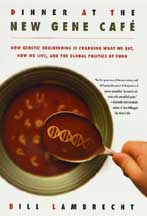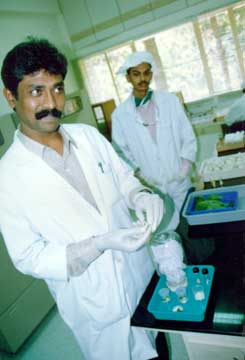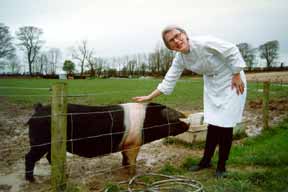) |
 Like it or Not, The New Gene Cafe is Open … And You’re Already Dining There Like it or Not, The New Gene Cafe is Open … And You’re Already Dining There
In his just-published book, Dinner at the New Gene Cafe, Bay Weekly co-founder and editorial adviser Bill Lambrecht tells how scientists set about rearranging the building blocks of our food by gene splicing.
Scientists and plant-researchers have bred better plants for many years using natural methods, and civilization is the better for it. What they began doing somewhat quietly a few years ago was engineering new traits into animals and plants, sometimes crossing from one kingdom into the other, in their quest for better genetically modified organisms, which much of the world calls GMOs. For instance, they’ve experimented with fish genes in tomatoes hoping to produce tomatoes that better tolerate the cold.
Pulitzer Prize-winning author Richard Ben Cramer - whose new best-seller, Joe DiMaggio: The Hero’s Life, proves he knows a good story - calls Dinner at the New Gene Cafe “the first big story of the new century.”
 Bill Lambrecht, he says, “owns it.” Bill Lambrecht, he says, “owns it.”
What’s a guy from Chesapeake Country doing on top of a story like this?
Since 1983, Bill Lambrecht has been a Washington correspondent for the St. Louis Post-Dispatch. A veteran political writer, he has in recent years written primarily about the environment and natural resources.
For the Post-Dispatch, he tracked toxic waste brokers from industrialized nations to Africa and developing countries, exposing their practice of dumping their deadly messes cheaply in the poorest - and least technologically able - nations in the world. He chronicled similarly dangerous dumping on American Indian lands from Arizona to Alaska, shaming the dumpers and the government in the process. Those stories won him more than a half-dozen journalism awards. In 1999, for his articles on genetic engineering from around the world, he was awarded the Raymond Clapper Prize for Washington reporting, the third time he won that award.
In reporting this story, Lambrecht traveled in 13 countries - including India and Brazil - encountering memorable characters along the way that star in his book, published this month by St. Martin’s Press.
Q GMOs. It’s a brand-new word for most of us. Perhaps you should start by telling us what it means.
A GMO is short for genetically modified organism, which is what you get when you move genes across the traditional species. It’s a technology that has been around just since the mid-1990s, developed by companies with some even bigger plans for changing what we eat. Americans don’t use the acronym GMOs very much - but I’d venture to say that most Europeans can tell you what it means.
Q So it’s another outpost of our brave new world by corporate design. Which companies?
A Some of the big ones are Aventis CropScience, DuPont, Dow, Novartis, Syngenta and especially Monsanto, which has its headquarters in St. Louis. That’s what punched my ticket to do all this travel.
 Monsanto scientists in India prepare individual gene cultures as part of their effort to fuse ‘useful’ traits from one species into the genetic makeup of another. Monsanto scientists in India prepare individual gene cultures as part of their effort to fuse ‘useful’ traits from one species into the genetic makeup of another.
photo by Bill Lambrecht
Q Isn’t Monsanto a chemical company? Didn’t they make Agent Orange and Astroturf?
AThat’s the company, a 100-year-old St. Louis corporation that has produced a lot of chemicals over the years. Agent Orange was a nasty herbicide - concocted by Monsanto and several other companies - that was sprayed in Vietnam to destroy foliage and thereby make it difficult for the enemy to hide.
Monsanto also manufactured PCBs, used in electrical transformers and such and now the source of some broad health concerns. And yes, there was Astroturf. If you’re a baseball fan, that may be enough to make you wonder about the company.
Q Why are companies like Monsanto pushing GMOs?
AThe short answer is because they can; they have the technology and, despite the uproar they have caused, they are making a profit.
Monsanto’s bread and butter over the years has been agriculture chemicals, like the wildly successful Roundup, so the company always was on the cutting edge of giving farmers chemicals that can simplify their work. That fact dovetailed with genetic experimentation going on in the early 1980s, in which scientists from Monsanto and other companies and universities developed methods to transfer genes across species borders. Ultimately, they engineered genetic traits into plants - mainly soybeans and corn - that either did what chemicals had done or worked in tandem with chemicals they owned.
Q What genetic modifications are they giving us?
A I’ve heard it said that science is marching us toward a new gene smorgasbord, with many foods seasoned with DNA that has never before existed in the supply of human food.
The seed catalogue of modified foods tested in the United States is thick. In thousands of experiments, companies and university scientists, too, conducted tests engineering new traits into canola, cucumbers, melons, rice, squash, strawberries, sugarcane and wheat, to name a few. Also, there were apples, coffee, cranberries, eggplants, oats, onions, peas, pineapples, plums, raspberries, sweet potatoes, walnuts and watermelons. There have been tests on just about every food plant that grows.
Q Are we eating any of those experiments?
A There aren’t a lot of whole foods at the table of genetically altered food. There were tomatoes, but they didn’t taste like what we could grow in the garden.
On the other hand, thousands of processed foods around the world contain genetically modified ingredients, especially foods that contain soybeans and corn that sprouted from genetically engineered seeds.
Q The GMO everybody probably knows about is StarLink corn.
AThat’s right. StarLink caused quite a scandal a year ago. StarLink was a kind of genetically modified corn that was allowable only for animal feed because of concerns of allergic reactions. But StarLink got mixed with other corn, which triggered a recall of taco shells, tortilla chips and many other products.
Q So there are more GMOs out there?
AStarLink is only the tip of the iceberg. As much as 70 percent of processed food could have some sort of gene-altered ingredients. Tests by Consumer Reports and interest groups found GMOs in breakfast cereals, corn and tortilla chips, granola bars, cake and muffin mix, corn meal, dog food, soy burgers and powdered chocolate drink, for instance. GMOs were also found in three types of baby food.
They’re drunk as well as eaten. Cola and soft drinks contain high fructose syrup made from bulk corn that may have engineered hybrids mixed in. Dairy farmers are using a genetically engineered hormone that induces cows to give more milk. Barley breeders were talking about using genetically engineered varieties for beer.
Q If GMOs are so fully integrated into American life, why were Taco Bell’s StarLink shells, which were later withdrawn from the market, the first we knew about GMOs in our food?
A We’re eating genetically modified foods regularly but we don’t know which ones because, unlike Europe, Japan and Australia, our governments in the United States and Canada don’t require this information on food packaging labels. That’s why we’re unaware of how deeply the technology already has reached into our cupboards.
Q Are we getting any good of it?
A Not much so far. The DNA of plants has been manipulated primarily to make growing them easier. Companies have profited and farmers have saved money by heading better equipped into the battle with weeds and insects. Even so, family farmers everywhere are hurting in part because of consolidations and mergers.
Up to now, there’s been little in the technology to inspire consumers with food that is more nutritious or more appealing.
Q When you say better equipped, what kind of equipment are we talking about? Little boxing gloves?
AIn a way. Monsanto’s leading GMO is Roundup Ready crops, which work in partnership with its Roundup herbicide, the world’s best selling weedkiller.
Roundup Ready seeds have been engineered for herbicide tolerance, and they pass on this trait to the next generation of plants. Any brand of Monsanto-invented glyphosate will be like water off a duck’s back on these plants, even as the chemical chokes yellow foxtail, velvet leaf and any other undesireable vegetation in a farmer’s dirt. By spraying a solution enriched with a quart or so of glyphosate per acre, you kill the competition for nutrients and give your plants room to spread. It’s a system: plant the seed and then spray the proprietary chemical for which it’s genetically engineered.
So Monsanto profits twice. When farmers buy Roundup Ready seeds to fight weeds, they must buy Roundup herbicide too.
The life-science companies haven’t yet figured out how to profit so grandly on their insect killer, which is Bt.
Q What’s that?
A Bt, which stands for bacillus thuriengensis, is a natural-occurring insecticidal soil bacteria and a dependable tool in this world of gardeners and organic farmers. Now it’s been engineered into corn so that the corn produces its own Bt. The concern, which strikes me as valid, is that pests will develop resistance because so much is being used. That’s what happens in evolution. And what will gardeners and organic farmers do then?
The up side is that the engineered crops have led to cutbacks in spraying of some pretty dangerous chemicals, especially those used on cotton in the South. That’s a good thing.
Q Haven’t we read reports that Bt may not be good for beneficial insects, like monarch butterflies?
AThat’s true. Monarch larvae were killed by Bt pollen from modified corn in widely publicized laboratory tests at Cornell University in 1999.
The EPA had required tests of the pollen on bumble bees and aquatic insects, but hadn’t bothered to determine whether non-target insects, like the monarch, were susceptible.
The scope of the Cornell monarch study was narrow; just 11 caterpillars died, one of the researchers told me. Still, it became a flashpoint in the debate. I think what it will come down to is measuring the costs and benefits, which we do with any technology.
Q How about “The Terminator,” something else that was in the news? That’s a fearful sounding character.
A Arnold Schwarzenegger sure was tough in the film, wasn’t he? The gene construct that bears his name thanks to clever critics is about as tough. “The Terminator” is a set of genes that interrupts germination. In other words, the seeds of these genetically modified plants are sterile and therefore useless if planted. So farmers have to return to their seed companies - most of which are now owned by the manufacturers of GMOs - to buy seed and pay a “technology fee.” The Terminator isn’t in production yet, and it hasn’t been too controversial in the United States. But it has stirred up quite a ruckus around the world, where 70 percent of farmers save their seed to replant for the next season’s crop.
Q So far we’ve been talking about GMOs that are good for Monsanto and maybe good for farmers and maybe not good for monarch butterflies. Is there any good for consumers in genetically modified food?
A Not much so far. Up to now, the technology has been used to make farming easier. I think you could argue that cutting back on some of the farm chemicals is a benefit. But consumers don’t think too much about that. There are promises about better and healthier food in the future - but those promises are as yet unfulfilled.
Q What are these promises?
A A lot of them deal with producing food that is made healthier by engineering in more vitamins and minerals. For the last 25 years, there’s been emphasis on taking things out of what we eat: food with less sugar, less fat, less cholesterol. Now they’re talking about putting things into food, such as creating bananas that carry vaccines.
You may have heard about so-called golden rice, which is yellow rice engineered to produce extra levels of beta-carotene, which converts in the body to vitamin A. A lack of Vitamin A is a cause of blindness in poor countries.
Companies have talked about producing salt-tolerant crops, which would be a great thing in developing lands. The companies held out the prospect, perhaps fanciful, of engineering nitrogen-fixing plants, which would cut back on the amount of fertilizers we use. A lot of this is complex stuff and it remains to be seen if it will come to pass.
Q On the flip side of the coin, what’s the likelihood that GMOs won’t be any better for people than for monarch butterflies?
A Some people have complained of allergic reactions, but I was not aware of solid evidence of harm when I was looking at these issues full-time.
The concerns, I’d say, are environmental and political. On the environmental side, many advocacy groups worry that we are forever changing the ecosystem, indeed redirecting evolution, with plants that never have existed in nature before. What happens when plants like these cross with their weedy relatives? Are we creating, for instance, strains of weeds that can never be eradicated?
 In Europe, anti-GMO activists warn of the dangers of genetically engineered foods. In Europe, anti-GMO activists warn of the dangers of genetically engineered foods.
photo by Bill Lambrecht
Q The subtitle to your book says it’s about the global politics of food as well as about genetic engineering …
A The politics is what I write mainly about. I use that term generally, meaning the politics of how public decisions are made.
There is a real concern in the approval process in some countries that there’s been too much corporate science and not enough public science in developing these new crops. There’s a worry that there’s a risk in giving a few companies control over the genetic composition of our food, which is the system taking shape. After all, monopolies in food are different than, say, monopolies in computers.
Q Before you continue, let’s focus on something you’ve just said. Why is it that we’re long on corporate science and short on public science?
A It’s something that’s been happening for a while. Government funding for research at state universities has dropped like a rock. Meanwhile, corporations make money deals with universities that lead to questions about objectivity of research. And by and large, government basically looks at what the research companies do rather than doing it themselves.
GMOs are a case in point. Most people don’t know this, but the government does little or no testing of its own of these new foods. Nor, somewhat strangely, is there mandatory pre-market testing of these new foods by companies. Instead, there’s something called a “consultation process” in which companies tell the FDA what they’re doing. And when food is actually out there, nobody is checking on its genetic constituents.
Q Okay, you can get back on track. You were listing some of the public policy issues skipped over in the rush to get GMOs to market.
A There are people who don’t care to eat food from intensive agriculture production, such as factory hog farms.
That gets to another issue: the right to know. The United States and Canada remain the only democracies of note not to require labeling of foods derived from genetic engineering. On the flip side of this, organic companies were forbidden this year to use the phrase “no GMOs” on products. This is a big debate to come in this country.
Q Are you suggesting that the rest of the world is already talking about such questions?
ANot only talking about them. There’s been a huge backlash around the world, especially in Europe, to tinkering with the genes of something as important as food.
Q By backlash, what do you mean? Protests in the street?
ANot just protests but intense news coverage, politicians put on the spot and even crop sabotage. By happenstance, I was on hand in rural England for the biggest such sabotage in history: 500 or so people rampaging through a genetically modified field and ripping up plants with spooky music from Pink Floyd wafting from giant speakers. The police just watched.
The big thing, though, is the prohibition thrown up by the European Union, an alliance of 15 European nations. With some exception, Europe has closed its doors to imports and plantings of GMOs. That reflects consumer concerns, and it’s a big deal abroad and a big market lost to American farmers.
Had there not been a backlash against genetically modified food in many parts of the world, there would be a lot more modified goodies in our diets today.
Q What does Europe and the rest of the world know that we don’t?
AEurope is much more attuned to where food comes from. It has to do with having suffered deprivation in the past. Plus, Europeans have been more focused on what they eat than Americans generally are. You can bet that McDonald’s never would have started in Paris. There’s another part of this puzzle: Mad Cow disease - this horrible brain disorder that afflicted European cows and spread to humans - eroded people’s faith in science and in regulators who told them it was nothing to worry about. Then people started to die.
Q Why is Europe a big deal in all this?
A Western Europe is the world’s richest market, 400 million or so well-to-do people. A big chunk of the world is made up of former European colonies that take their cue from their former motherland.
Q You have a lot of characters in your book. Are any of them particularly memorable?
A Because genetic engineering business is such an abstraction, I tried to pose the debate through the eyes of people around the world. Meeting people is the best part of my job, and some of them really stick in my mind. I liked some of the Monsanto scientists - who may not have felt the same toward me because of my stories about the reaction to their achievements.
I spent time with a lot of farmers, people like Earl Sime, a wise Iowan who laid it on the line as far as the desperation and powerlessness farmers are feeling. In Ireland, there was Darina Allen, that nation’s well-known chef, who lambasted the gene-manipulators while she escorted me through the idyllic grounds of her Ballymaloe Cookery School.
There was Rene Riesel, the tough little crop saboteur in France who chain-smoked through lunch in a fancy Paris cafe. I also recall the shaman in the Panamanian rain forest that I got to by dugout canoe. When I asked him if he would share his jungle secrets with the gene-jockeys, he said sure, if they pay me. Then after I took his picture, he said I owed him five bucks.
 Irish chef and TV personality Darina Allen is her country’s most prominent anti-GMO activist. Irish chef and TV personality Darina Allen is her country’s most prominent anti-GMO activist.
photo by Bill Lambrecht
Q What’s it going to take to get Americans thinking about tinkering with the genes of something as important as food?
A I think there will be protests, debates about labeling and more attention paid in the coming months. Another StarLink episode or even a health scare would ratchet up the debate. Judging by the explosive growth in the organic food industry, it seems to me that people are paying more attention to what they eat these days.
QNowadays we Americans are preoccupied with the terrorist attack of September 11 and its consequences. All other public issues may fade from view in the terrible light of this tragedy. Could that happen?
A This public crisis has no precedent in modern times because of the death and destruction on American soil. But as horrible as it is, I think most of the country will gradually return to normal - unless there are breaking news events and not just recapitulation of the horrors. And normal means thinking about what is best for our families, including what they eat.
Bill Lambrecht’s book is now in bookstores everywhere including Amazon.com.
His national tour begins in Chesapeake Country. Meet him at an author’s reception at Bay Weekly Friday, September 28 from 4:30–8pm.
Then, on Thursday, October 11 at 7:30pm, he’ll read from his book, answer questions and sign copies at Barnes & Noble in Annapolis Harbour Center.
In November, you can meet him at Borders Books in Bowie.
Copyright 2001
Bay Weekly
|